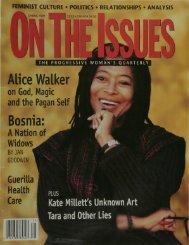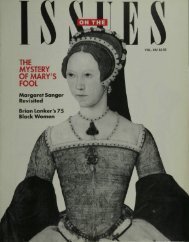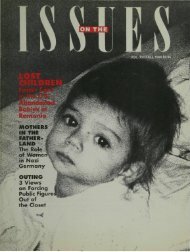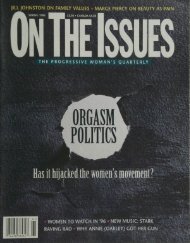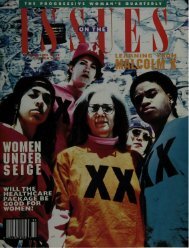300 Years & Counting 1H KILLS - On The Issues Magazine
300 Years & Counting 1H KILLS - On The Issues Magazine
300 Years & Counting 1H KILLS - On The Issues Magazine
You also want an ePaper? Increase the reach of your titles
YUMPU automatically turns print PDFs into web optimized ePapers that Google loves.
Salem Village began, in November 1691, tomeet at the parsonage to have their fortunestold by a slave named Tituba. Eight-year-oldBetty Parris and 11-year-old Abigail Williamswere the daughter and niece of the Rev.Samuel Parris, a failed merchant turned ministerwho had alienated half his new congregationwith his insistance that the parsonagebe deeded to him in perpetuity. Tituba hadbeen purchased by Parris in Barbados, andshe brought north with her beliefs and customsconsidered little more than "devil worship"by white Christians. She cared for thegirls while their elders worked or went onvisits to Parris' far-flung congregants. Usingeggwhites in a glass bowl as a crystal ball,Tituba tried to answer what for Puritan girlswas a question of maximum importance —what sort of man will I marry?Though the girls tried to keep it secret, wordof their seances spread, and Tituba's circleexpanded to include girls and young womenfrom nearby Salem Town. By some accounts,the younger girls became frightened whenthey saw floating in the eggwhites the imageof a tiny coffin.Sometime in January 1692, Betty Parris 'and Abigail Williams began to suffer seizuresso violent that eyewitness John Hale believed :them "beyond the power of...natural disease ito effect." <strong>The</strong> sickness spread to others inTituba's circle, chief among them 12-year-old | ;Anne Putnam Jr., and the symptoms prolifer- ,ated—intermittent blindness, deafness, and Iloss of speech and appetite, amnesia, choking,hallucinations. "<strong>The</strong> afflicted," as they cameto be called, cried out that they were beingstabbed, bitten, pinched, burned, mutilatedby specters only they could see. Several developedstigmata — actual bruises or welts — asif in response to these invisible assaults.Modern medicine might use terms like "hysteria"or "conversion reaction" to describewhat was happening, but Salem physicianWilliam Griggs told Parris that "the evil hand"was upon his girls. When Betty cried out forTituba, Parris took this as an accusation. Hebeat the slave until he had a "confession."Tituba admitted to being a witch, implicatedVillage residents Sarah Good and SarahOsborne (whom Betty and Abigail had alsocried out against), and spoke of other witchesand "a tall man of Boston" whom she couldn'tidentify. Tituba, Good and Osborne were arrested.Accusations, hearings, trials and executionsfollowed in rapid succession. Bridget Bishopbecame the first accused witch to die on GallowsHill on June 2,1692. <strong>On</strong> July 19, RebeccaNurse, Susannah Martin, Elizabeth Howe,ON THE ISSUES SUMMER 1992In this 17thcentury"FatalAttraction,"the ultimatepersecutorsare womenSarah Good and Sarah Wilds were executed,followed on August 19 by George Jacobs,Martha Carrier, George Burroughs, JohnProctor and John Willard. <strong>On</strong> Sept. 19 GilesCorey was tortured to death in a nearby fieldfor refusing to cooperate with the court. <strong>On</strong>Sept. 22 came the turn of his wife Martha,executed along with Margaret Scott, MaryEsty, Alice Parker, Ann Pudeator, WilmottRedd, Samuel Wardwell, and Mary Parker.By November, the witch hunt was spent. Inpart, this was due to the behavior of theafflicted girls. By accusing "respectable"women like Rebecca Nurse and ElizabethProctor, and men (not to mention a formerjustice of the court and the governor's wife),they made the ruling elite itself vulnerable toaccusations of witchcraft. Governor Phips orderedan end to the sessions of the specialcourt he had appointed, and within months anew court, using different rules of evidence,acquitted almost all those still in jail awaitingtrial. Those convicted were pardoned, butsome of the accused, too poor to pay therequired fees for their imprisonment, wouldremain in jail for years. Lydia Dastin diedthere. And the Commonwealth ofMasschusetts would not exonerate those executeduntil 1954.As with the European witch craze, the reasonsfor Salem are diverse and complex. Puritansociety was under great strain, its verysurvival in doubt. <strong>The</strong> original Massachusettscharter, which had given the colonyunprecedented freedom from the crown, wasrevoked in 1684, the new charter imposed in1692 lessened this autonomy and doomedPuritan hegemony. For the first time, non-Puritans would be allowed a role in government,and there would be no more hangings ofQuakers. This threat came at a time whenNative Americans, allied with the French,were making successful attacks on Puritansettlements, and both Salem and Boston werefilled with refugees from the threatened frontier.Salem Village itself was torn by thechoice of Parris as minister, and by commercialand property disputes.Little of this figures in contemporary accountsof the trials. <strong>The</strong> first of these was byBoston minister Cotton Mather, the leadingcleric of the day. Although Mather privatelyopposed the court's reliance on the versions ofthe afflicted — so-called "spectral evidence"— he also feared that public revulsion at thetrials' excesses would undermine an alreadytottering Puritan theocracy. His book <strong>The</strong>Wonders of the Invisible World was rushedinto print in late 1692, or early 1693, despitea ban imposed by Governor Phips on works13




